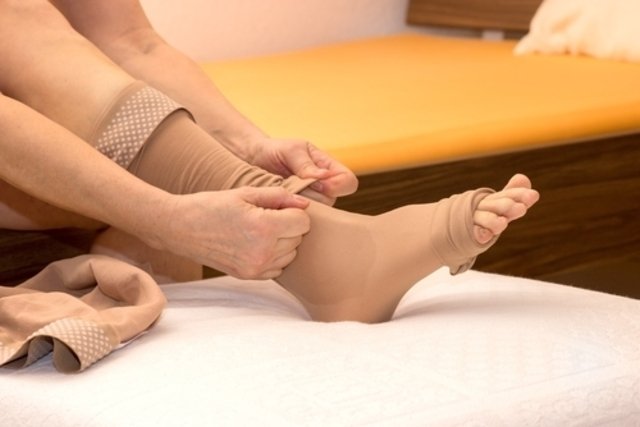The treatment of deep vein thrombosis generally involves anticoagulant medications such as heparin or warfarin and, in the most serious cases, surgery, and should be started as soon as possible to avoid complications such as pulmonary embolism.
Although venous thrombosis can be cured through appropriate treatment, the risk of it happening again is high. Therefore, the use of anticoagulant medications is generally indicated even after improvement and may be necessary for a long period depending on this risk. Learn how to identify the symptoms of deep vein thrombosis.
If thrombosis is suspected, it is recommended to go to an emergency room for an evaluation, because when identified and treated quickly, it is possible to prevent the condition from getting worse and reduce the risk of complications in the future.

Treatment options
The main treatment options for deep vein thrombosis include:
1. Anticoagulant medicines
Anticoagulants, such as heparin or warfarin, are generally indicated because they reduce the blood’s ability to clot, allowing the clot to be broken down by the body and preventing others from forming. Discover the main anticoagulants and what they are for.
Normally, in case of deep vein thrombosis, treatment with anticoagulants is carried out with tablets and lasts around 3 months. However, in some cases the use of injectable anticoagulants may also be indicated and anticoagulation may be recommended for a longer period of time depending on the risk of having new episodes of thrombosis.
During treatment with anticoagulants, regular blood tests are generally indicated, such as measuring TAP and INR, to assess clotting capacity, adjust doses and avoid complications, such as bleeding or anemia, for example.
2. Thrombolytic medications
Thrombolytic medications, such as streptokinase or alteplase, are injectable and generally indicated in more severe cases of thrombosis and in younger people. In this case, treatment normally lasts around 7 days and is carried out in hospital due to the risk of complications such as bleeding.
3. Surgery for thrombosis
Surgery is used in the most serious cases of deep vein thrombosis or when it is not possible to dilute the clot with the use of anticoagulants or thrombolytics.
Surgery for deep vein thrombosis serves to remove the clot from the legs or to place a filter in the inferior vena cava, which prevents the clot from passing to the lungs.
4. Natural treatment
Some teas, such as ginkgo or chamomile tea, which have antithrombotic properties, can also be used. However, its use must be communicated to the doctor, because if used in conjunction with anticoagulant medications, they may increase the risk of bleeding.
Furthermore, the use of these remedies should not replace medications recommended by your doctor. See how to prepare ginkgo tea.
Is there a cure for deep vein thrombosis?
Deep vein thrombosis can be cured, however, even after adequate treatment, the risk of having a new episode is high. Furthermore, the risk of complications such as pulmonary embolism and symptoms such as swelling, heaviness in the legs and wounds is still high after the first episode of thrombosis and can last for months.
Consult your nearest doctor to receive the best guidance on how to cure thrombosis:
Taking care of your health has never been easier!
Signs of improvement or worsening
When the treatment is effective, signs of improvement in thrombosis can be observed, such as a reduction in redness and pain, which appear a few days after starting treatment. However, even with appropriate treatment, leg swelling tends to take longer to reduce and may persist for a few weeks before completely disappearing.
In more serious cases or without adequate treatment, symptoms such as sudden difficulty breathing, chest pain, dizziness, fainting or coughing up blood may occur, indicating the worsening of thrombosis with pulmonary embolism, which is when clots in the legs move to the lungs. Understand better what it is and how to identify the symptoms of pulmonary embolism.
Bibliography
- KRUGER, Paul C. et al. Deep vein thrombosis: update on diagnosis and management. With J Aust. Vol.210, n.11. 516-524, 2019
- TAN, Christina S. S; LEE, Shaun W. H. Warfarin and food, herbal or dietary supplement interactions: A systematic review. BJCP. Vol.87, n.2. 352-374, 2020
- STATPEARLS. Deep Vein Thrombosis. 2021. Available at: <https://www.ncbi.nlm.nih.gov/books/NBK507708/>. Accessed on Aug 24, 2022
- STUBBS, M. J; MOUYIS, Maria; THOMAS, Mari. Deep vein thrombosis. BMJ. Vol.360. 351, 2018

Sign up for our newsletter and stay up to date with exclusive news
that can transform your routine!
Warning: Undefined array key "title" in /home/storelat/public_html/wp-content/plugins/link-whisper-premium/templates/frontend/related-posts.php on line 12
Warning: Undefined array key "title_tag" in /home/storelat/public_html/wp-content/plugins/link-whisper-premium/templates/frontend/related-posts.php on line 13




